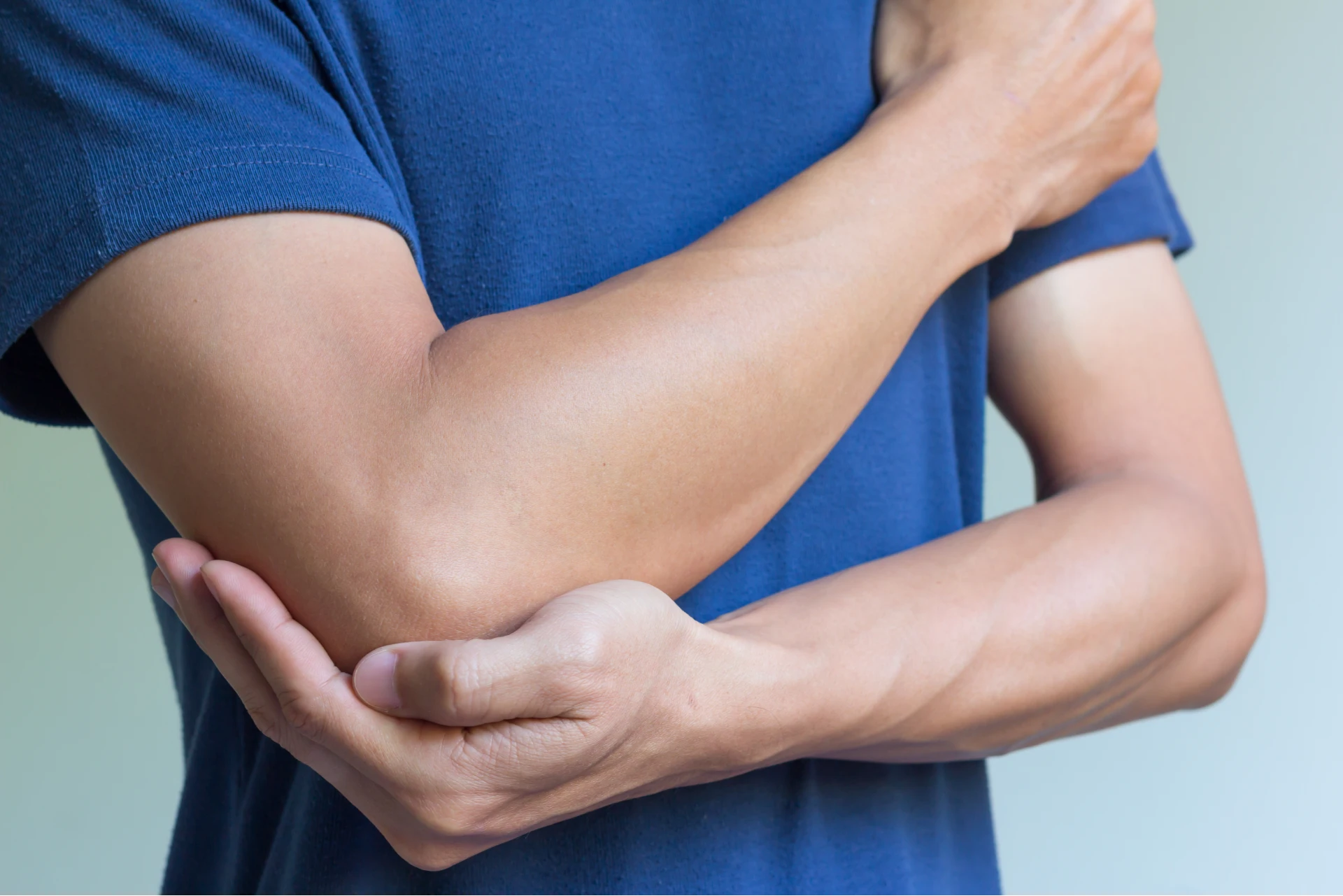The elbow joint is a complex structure that plays a crucial role in the functioning of the upper limb. Everyday activities and sports can stress the elbow. This stress often leads to injuries and elbow pain conditions. Identifying the location and nature of the elbow pain is crucial to determine the appropriate treatment approach.
Knowing how the elbow works helps us find and fix problems like injuries or conditions. The elbow is amazing because it lets us bend, straighten our arms, and turn our forearms. The elbow consists of:
Let’s dive deeper into elbow anatomy and processes.

01
Distal Humerus and Radial Head: The distal humerus and radial head are parts of the bone structure in the elbow joint. They play crucial roles in the articulation and movement of the elbow.
02
Synovial Joint and Synovial Fluid: The elbow joint has a capsule around it. It’s filled with synovial fluid. This fluid greases and feeds the joint surfaces, making movement smooth.
The proximal radioulnar joint plays a crucial role in forearm rotation and movement, potentially affecting elbow pain.
03
Brachial Artery and Blood Supply: The brachial artery gives blood to the arm and elbow area. It helps tissues get oxygen and nutrients to work right and heal.
04
Triceps Brachii and Biceps Brachii: The triceps brachii and biceps brachii are big muscles in the upper arm. They help move and stabilize the elbow.
Median Nerve: This nerve provides sensation to the palm and fingers of the hand. Nerve damage can happen from injury, pressure, doing the same thing over and over, or conditions like carpal tunnel syndrome.
Radial Nerve and Ulnar Nerve: The radial and ulnar nerve are two vital nerves that provide sensation and control movement in the arm and hand. These nerves arise from the brachial plexus and travel down the arm, passing through the elbow and forearm.
Cubital tunnel syndrome is when the ulnar nerve becomes compressed at the elbow, leading to pain and numbness.
01
Common Flexor Origin and Common Extensor Origin: The common flexor origin and extensor origin are where forearm muscles connect. They help bend and straighten the elbow.
02
Annular Ligament and Joint Capsule: The annular ligament and joint capsule keep the elbow joint stable. They stop it from moving too much and provide support.
03
Muscles: Flexor and extensor muscles work in tandem to facilitate bending and straightening of the elbow joint.
04
Trochlear Notch and Olecranon Fossa: The trochlear notch is a dent in the ulna bone. It joins with the humerus, making the elbow hinge. The olecranon fossa is a dent in the humerus bone. It fits the olecranon process of the ulna when the elbow stretches.
05
Soft Tissues and Ligaments: Soft tissues surrounding the elbow include muscles, tendons, ligaments, and other structures. Trauma, overuse, or medical conditions can damage these tissues. The radial collateral ligament helps stabilize the outer side of the elbow joint.
Elbow pain occurs for various reasons, such as overuse or injury. Tennis or Golfer's elbow, or lateral and medial epicondylitis, is common with elbow pain.
Also, elbow tissue damage can happen from injuries, repeated strain, or medical issues. The health of radial nerves affects sensation and motor function in the elbow region. Conditions like rheumatoid arthritis can compromise these nerves.

Tennis elbow, or lateral epicondylitis, is a condition where pain develops outside the elbow due to overuse of the forearm muscles. These muscles help with gripping and lifting. It can cause irritation and swelling of the tendons connected to the lateral epicondyle, a bony bump outside the elbow.
Repetitive motion activities cause excessive strain on the elbow joint. The elbow pain may radiate from the elbow joint down the forearm and worsen with activities that involve gripping or twisting motions.
Treatment for tennis elbow pain includes:
Rest
Ice therapy
Bracing
Physical therapy to strengthen the muscles
Steroid injections or surgery in severe cases.
Understanding the cause of tennis elbow is crucial for reducing pain and restoring function to the affected elbow joint.
Elbow pain originating from the medial epicondyle can indicate issues with the flexor muscles and surrounding tissues. Golfer’s elbow, medically known as medial epicondylitis, causes pain and discomfort on the inner side of the elbow joint.
Golfer’s elbow happens from overuse or repeating movements. It strains the muscles and tendons connected to the medial epicondyle, a bony bump inside the elbow.
Playing golf or racket sports, where you grip, swing, or throw, can cause this condition. Golfer’s elbow might bring pain and tenderness around the elbow joint, which may spread down the forearm.
Treatment for elbow pain is often similar to that for tennis elbow. Therapy includes rest, ice therapy, stretching, and strengthening muscles. In severe cases, doctors may suggest steroid injections or surgery to reduce symptoms and promote healing.
An ulnar collateral ligament (UCL) injury commonly affects the elbow joint, causing pain and instability. The UCL is a band of tissue on the elbow’s inner side that helps stabilize the joint during throwing motions and other activities.
Damage to the joint capsule can lead to instability and increased susceptibility to elbow pain. This ligament can get injured from repetitive stress, sudden trauma, or overuse. Athletes who play throwing sports like baseball or javelin are more likely to get this injury.
Symptoms of an Ulnar Collateral Ligament injury may include:
Elbow pain on the inner side of the hand
Swelling and instability when performing activities that stress the elbow joint
The treatment process for UCL injury involves:
Total resting
Using ice therapy
Doing physical therapy to strengthen the flexor and extensor muscles
Consider surgery for severe cases to repair or reconstruct the ligament.
Adequate blood supply is necessary for nourishing injured tissue, aiding healing, and alleviating elbow pain.
An elbow dislocation occurs when the bones that form the elbow joint are forced out of their regular positions. This usually happens due to a traumatic injury, such as a fall onto an outstretched hand or a direct blow to the elbow.
Elbow dislocations can damage the surrounding soft tissues, including ligaments, tendons, and nerves, and may cause severe pain, swelling, and loss of movement in the elbow joint.
Treating elbow dislocations involves realigning the bones, which may require sedation or anesthesia. After this, doctors may immobilize the elbow with a splint or brace to help it heal.
Radial tunnel syndrome is characterized by elbow pain and weakness in the forearm due to radial nerve compression. Early treatment and rehab are essential. They help reduce problems and make your elbow work better.
In this condition, the bursa, a small sac of fluid at the tip of the elbow, becomes inflamed and swollen. Repetitive pressure on the elbow, like leaning on hard surfaces for a long time, or direct trauma to the area can cause this inflammation.
Typically, it presents as a visible, swollen bump at the back of the elbow and may be accompanied by elbow pain, tenderness, and limited movement. Sometimes, the skin over the bursa may become red and warm to the touch.
Overuse injuries from repetitive movements can also lead to elbow pain and inflammation in the elbow joint.
Diagnosing common elbow injuries involves a comprehensive assessment of various factors, including:
The patient's medical history
Physical examination
Imaging studies such as magnetic resonance imaging (MRI) or X-rays.
For conditions like tennis elbow and golfer's elbow, characterized by pain and tenderness around the lateral and medial epicondyles respectively, the diagnosis often relies on:
Clinical presentation
Specific tests to elicit pain or weakness in the affected areas.
In cases of suspected ligamentous injuries such as ulnar collateral ligament (UCL) tears or radial collateral ligament (RCL) injuries:
Stress testing
MRI or Ultrasound
Furthermore, for elbow dislocations or olecranon bursitis, physical examination coupled with imaging modalities can aid in determining the extent of soft tissue damage and any associated fractures.
Additionally, for evaluating vascular injuries or conditions affecting blood supply:
Assessing blood flow to the affected area through blood samples or Doppler ultrasound.
Overall, a multidisciplinary approach, including orthopedic specialists, radiologists, and physical therapists, is essential for accurately diagnosing and effectively managing various elbow injuries to provide optimal pain relief and promote recovery.

Various treatments aim to reduce pain and improve function in the elbow joint.
Physical therapy aims to restore function and stability in affected joints. Steroid injections can ease elbow pain, or doctors may suggest exercises to strengthen the joint and improve stability. Applying ice or frozen peas wrapped in a cloth can help reduce inflammation in cases of severe pain. Let’s dive closer:
01
Conservative Measures: Rest, ice pack, compression, and RICE will help relieve elbow pain and reduce inflammation.
Physical methods: Strengthening exercises are essential for rehabilitating damaged tissue and improving the stability of synovial joints like the elbow.
Steroid Injections: Corticosteroid injections can temporarily relieve pain and inflammation. They’re helpful for conditions like tennis elbow and olecranon bursitis.
Surgical Intervention may include ligament repair or reconstruction, arthroscopic surgery, or elbow joint replacement.
Blood Sample: It may be taken to check for inflammation or infection in the elbow joint. This is important for synovial joint conditions, such as the elbow.
Checking blood flow is important for assessing joint health. This is especially true for hinge joint, which is crucial for movement and flexibility.
Elbow pain can be caused by various factors such as injury, overuse, or inflammation. Preventing elbow joint injuries involves taking several measures. Patients can take proactive steps to reduce the risk of elbow injuries and conditions. It helps protect the structures around the elbow and minimize the risk of damage.
These steps consist of:
Avoiding repetitive motions or overloading the elbow joint during activities.
Using proper technique and equipment during sports and physical activities.
Incorporating strength and flexibility exercises into regular workouts to maintain joint health.
Listen to the body and seek prompt medical attention for any signs of discomfort or elbow pain.
The elbow is a vital joint that facilitates essential upper limb movements. Knowing about elbow pain problems and how to treat them helps keep elbows healthy. To avoid problems, do things right, see a doctor if needed, and follow tips to prevent them. This way, you can stay active without worrying about elbow problems.
Located in Valley Stream and Brooklyn, we are committed to excellence by pledging to provide the highest quality of orthopaedic care possible.
© Copyright 2023 Advanced Orthopedics & Joint Preservation, PC. All Rights Reserved